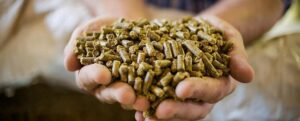
Ukrainian sunflower meal lost ground to Argentine sunflower meal on the European market for the first time in a long time, while rapeseed meal supplies reached a record low for five seasons, according to the information and analytical agency APK-Inform.
The agency cited data from the European Commission, according to which in July-August (2025-2026 MY for the EU) the European Union imported 118,000 tons of Argentine sunflower meal, accounting for 49% of total imports of this product, while the share of Ukrainian meal was 40%, or 96,000 tons.
According to Ukrainian statistics, in July, exports of Ukrainian sunflower meal to the EU halved, amounting to just over 50 thousand tons, and in August, according to preliminary estimates by APK-Inform, the smallest volume of this product since October 2021 was exported to the EU—only about 20-25 thousand tons.
Analysts recalled that in the 2024/25 season, Ukrainian sunflower meal accounted for 62% of total imports of this product, while Argentine sunflower meal accounted for 29%.
“The reduction in supplies in July-August this year is due to a decrease in sunflower processing by Ukrainian factories in the summer and, accordingly, a lower supply of meal. At the same time, the seasonally high supply of rapeseed meal on the European market became an additional limiting factor,” the experts explained.
Currently, analysts emphasized, Ukrainian rapeseed meal supplies to the EU are at their lowest level in more than five seasons (excluding 22/23 MY), which is due to the shift in rapeseed harvesting dates in Ukraine, low sales of oilseeds by farmers, and very low processing in July.
According to the European Commission, in the first two months of the 2025/26 season, the EU purchased only 1.6 thousand tons of rapeseed meal from Ukraine, or 1.3% of total imports. Currently, Canadian rapeseed meal dominates EU imports with a share of 84%. Last season, during the same period, the EU imported mainly Ukrainian products, which accounted for 82% of imports, according to APK-Inform.

The total volume of German exports, adjusted for calendar and seasonal factors, fell by 0.6% in July compared to the previous month, to €130.2 billion, according to a report by the Federal Statistical Office of Germany (Destatis). Imports decreased by 0.1% to €115.4 billion.
Year-on-year, exports grew by 1.4% and imports by 4.3%.
Exports to the US in July fell by 7.9% compared to June, to their lowest level since December 2021. This is the fourth consecutive month of decline. Shipments to China fell by 7.3%, and to the UK by 3.1%. Exports to European Union countries increased by 2.5%, while exports to Russia fell by 12.4% (to €526.5 million, a drop of 19.8% compared to July 2024).
Imports from EU countries rose by 1.1% last month, and from the UK by 7.8%. Supplies from China fell by 2.4%, from the US by 10%, and from Russia by 43.9% (to €80.7 million, a drop of 40.3% compared to a year earlier).
In January-July, exports from Germany to Russia fell by 6.8% compared to the same period last year, while imports fell by 37.4%.
Germany’s foreign trade surplus fell to €14.7 billion in July from €15.4 billion in June. A year earlier, the surplus was €17.7 billion.
Source: http://relocation.com.ua/nimechchyna-v-lypni-skorotyla-eksport-do-ssha/

Sunflower oil exports from Ukraine in August 2025 fell to 150,000 tons, which was the lowest monthly volume in more than three years and the second lowest monthly figure in almost 14 seasons, according to the information and analytical agency APK-Inform.
Analysts noted that the decline occurred in all major areas, in particular, there were no deliveries to India.
“The decline in exports of this product during the period was due to seasonal factors, in particular, a reduction in the supply of sunflower seeds on the domestic market, which limited processing, as well as a decline in demand from some importers in anticipation of cheaper oil from the new harvest,” experts explained.
They noted that, according to the results of the current 2024-2025 marketing year, Ukraine exported 4.73 million tons of sunflower oil, which is 24% less than the previous season and the lowest figure for the last three seasons.
“The main factors that limited exports of this product from Ukraine were the smaller sunflower harvest in 2024 and the low margin on its processing,” analysts recalled, adding that supplies to the main markets in the season that has just ended increased slightly.
The top three importers of Ukrainian oil were India (767,000 tons; +44% compared to 2023/24 MY), Spain (656,000 tons; +11%), and Italy (504,000 tons; +28%).
“Overall, the current season has been quite difficult for the Ukrainian sunflower processing sector, forcing factories to seek better profitability in soybean and rapeseed processing, and also prompting the promotion of ”soybean-rapeseed amendments,” APK-Inform summarized.

Over seven months of 2025, Ukraine exported frozen vegetables worth USD 6.1 million, according to an analytical review of the State Service for Agrarian Policy and Investments. The export structure is dominated by such products as frozen carrots, beets, celery, lettuce, chicory and potatoes.
The growth of frozen vegetable exports can be partly explained by the rapid development of the berry sector in the agro-sector. After the rapid increase in raspberry production, many companies invested in freezing facilities. Using them to their full potential, they expanded their product range to include a variety of fruits and vegetables.
Despite strong growth, Ukraine is still a net importer of frozen vegetables – exports are inferior to imports. This indicates the accumulated potential for further growth and diversification of the assortment in the future.
Key markets for Ukrainian frozen vegetables include Germany, Israel, Belgium, Italy, Poland, France, France, Italy and Romania.
Growing exports of frozen vegetables are a signal of industry adaptation and efficient use of resources. Particularly impressive is the diversification into frozen products, a move that allows Ukrainian producers to enter new markets and sustainably consolidate in existing ones. Nevertheless, the persistent deficit in the balance of exports and imports requires attention to quality, product mix and brand development. Increased support for local processors, modernization of freezing and logistics chains, and promotion in foreign markets are key factors for further growth.

Ukraine increased imports of lead and lead products by 7.7 times to $4.723 million (in July – $718 thousand), while exports of lead and lead products decreased by 15.6% to $5.482 million (in July – $1.022 million).
Lead is currently mainly used in the production of lead-acid batteries for the automotive industry. In addition, lead is used in the manufacture of bullets and certain alloys.

In January-June 2025, Ukraine increased exports of dairy products by 51.4% to 327,000 tons compared to 216,000 tons in the same period of 2024,
while exports of milk-containing products increased by 35.8% to 410,000 tons compared to 302,000 tons, according to the Ukrainian Dairy Industry Association (SMU).
The industry association noted that the share of milk that was processed and exported from the country in the form of dairy products is growing.
According to analysts, the growth was most noticeable in January-June: the ratio of exports of dairy and milk-containing products (in milk equivalent) to the volume of milk sent for processing was 22.7%, with an increase to 25.9% in the second quarter compared to 19.3% in the first quarter.
This means that while in the first quarter approximately one-fifth of milk was used for the production of dairy products for export, by the end of the first half of the year this figure had risen to almost a quarter of the milk sent for processing, experts explained.
“Milk processing plants in Ukraine are increasing milk purchases, fully meeting the needs of the domestic market, and using all available opportunities to develop export markets,” the SMPA assured.